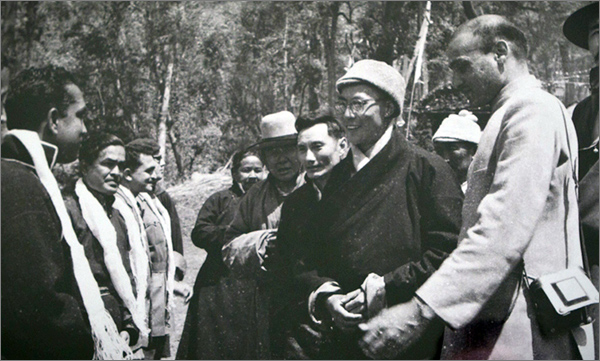
If the mantra of Sino-Indian relations is based on Panchsheel (as Beijing dubs it: Five principles of peaceful coexistence), not much of that was evident in the past months or so. The other more contemporary formula for New Delhi to engage is: cooperation and competition, or in other words, 'coopetition'. The term has undergone many evolutionary phases since it was first coined in 1913.
That apart, three pieces of news in quick succession seems to have put both India and China stepping onto an escalation ladder, where China has upped the ante by renaming six areas of Arunachal Pradesh ('South Tibet,' as the Chinese leadership calls it). This was in response to the Dalai Lama's visit to what can be called Indian territory as a legatee of the British imperial masters and their Simla Agreement of 1914.
In this context, Indian strategists would do well to keep in mind the famous Sun Tzu principle of winning a war without fighting it. The Chinese brush-off of a Moscow attempt to inject a little more cordiality between its old 'special strategic partner' India and its comparatively newer friend, China, can be read as climbing another higher rung in the so-called ladder.
Indian strategists would do well to keep in mind the famous Sun Tzu principle of winning a war without fighting it.
The other provocation to India was the language of the Chinese objection to Dalai Lama's visit. It seemed particularly trenchant to a finely tuned diplomatic ear. To recall, the English language Global Times termed it a "clumsy and rude" move. Considering that the newspaper is used by the residents of Zhongnanhai as a jackhammer, each time their primary choice of a lighter tool appears ineffective, the message to India was written in bold relief.
Each of these three moves requires closer examination. First, the Dalai Lama visit. The Chinese has claimed since the early 2000s that the Tawang monastery was an extremely sacred place for the Tibetans (the 5th Dalai Lama had got it built) and second largest in terms of size to the Potala Palace on Lhasa, the abode of the Dalai Lamas. To this end, the 14th Dalai Lama's visit to Tawang should have been taken by Beijing as a pilgrimage that supposedly all Tibetans cherish.
Interestingly, there is a Tibetan name for Tawang: as Hamlet Bareh had recorded in his Encyclopaedia of North East India of 2001. It is, Tawang Galdan Namgye Lhatse. 'Ta' means "horse" and 'wang' means "chosen," which together forms the word 'Tawang', meaning "the location selected by horse."
There is a Tibetan name for Tawang: Tawang Galdan Namgye Lhatse.
Delving into the specificity of the name of the monastery, 'Galdan' means "paradise", 'Namgye' means "celestial" and 'Lhatse' means "divine". Thus, the full meaning of Tawang Galdan Namgye Lhatse is "site chosen by the horse is the celestial divine paradise."
Surprisingly, though Beijing renamed six places of the state, according to supposedly old Tibetan tradition, and Romanised them, it did not use Chinese Pinyin to the Tawang monastery. The 14th Dalai Lama did not mention the Tibetan name when he visited the monastery and stayed there for three days last month. Chinese Pinyin script is used for simplifying the phonetic Chinese language, thus serving it up to the westerners for further Romanisation.
 The 14th Dalai Lama visits Tawang Monastery in 1959 | Photo: Sandro Lacarbona
The 14th Dalai Lama visits Tawang Monastery in 1959 | Photo: Sandro Lacarbona
Comparatively speaking, while this was certainly a step upward in the ratcheting up of the boundary dispute with India, it should beget a proportionate response from New Delhi. Or are the Indian decision makers seeking a way-out of the early aggressive measure?
But China has been proving to be a bugbear in this coopetition process. The way it is encroaching in continental South Asia and the maritime domain of the Indian Ocean, can raise the hackles of any Indian leadership that seeks to guarantee Indian national interest. Many global strategists believe that the Chinese use of the Gwadar port in Baluchistan is to bypass the chokepoint of the Malacca Straits, thus denying India the geostrategic advantage.
They see that Gwadar is fully ready and the Chinese could ship their supplies, including oil, from West Asia to the port and then transport it through the much touted China-Pakistan Economic Corridor (CPEC). Denying India a leverage, the strategic chessboard appears replete with moves and countermoves. Add to that the Indo-US relations that appeared warming a great deal during the Barack Obama administration, and the Chinese fear seems to have some rational basis.
Having said that, the early move by the Trump administration's attempt to raise the issue of Kashmir in the United Nations, appeared a soft and a small step in framing a South Asian policy. And in the process, it put India on notice that its aggressive moves in Syria were not an isolated case of intervention.
In those terms, the Trump Administration’s rabid anti-Islam position that could net Pakistan — a strategic calculus of the Indian strategists — seem to have faltered a little.
Finally, Russia. It will be an interesting idea to query India’s contemporary history of big power engagement, 'Who lost Russia.' For Russia, which is still sitting on the fence on the issue of Pakistan and China vis-à-vis India, is a far away move from the time when its veto in the UNSC was a default position that New Delhi can bank on blindly when any Indo-centric contentious issue came up.
So the rhetorical question is: In India's urge to match its elite’s 'exceptionalist' view for regional and indeed, global primacy, is the country walking into the Thucydides' trap, a supposedly favourite trope of the Chinese President and 'strongman,' Xi Jinping?
The views expressed above belong to the author(s). ORF research and analyses now available on Telegram! Click here to access our curated content — blogs, longforms and interviews.




 The 14th Dalai Lama visits Tawang Monastery in 1959 | Photo:
The 14th Dalai Lama visits Tawang Monastery in 1959 | Photo:  PREV
PREV


